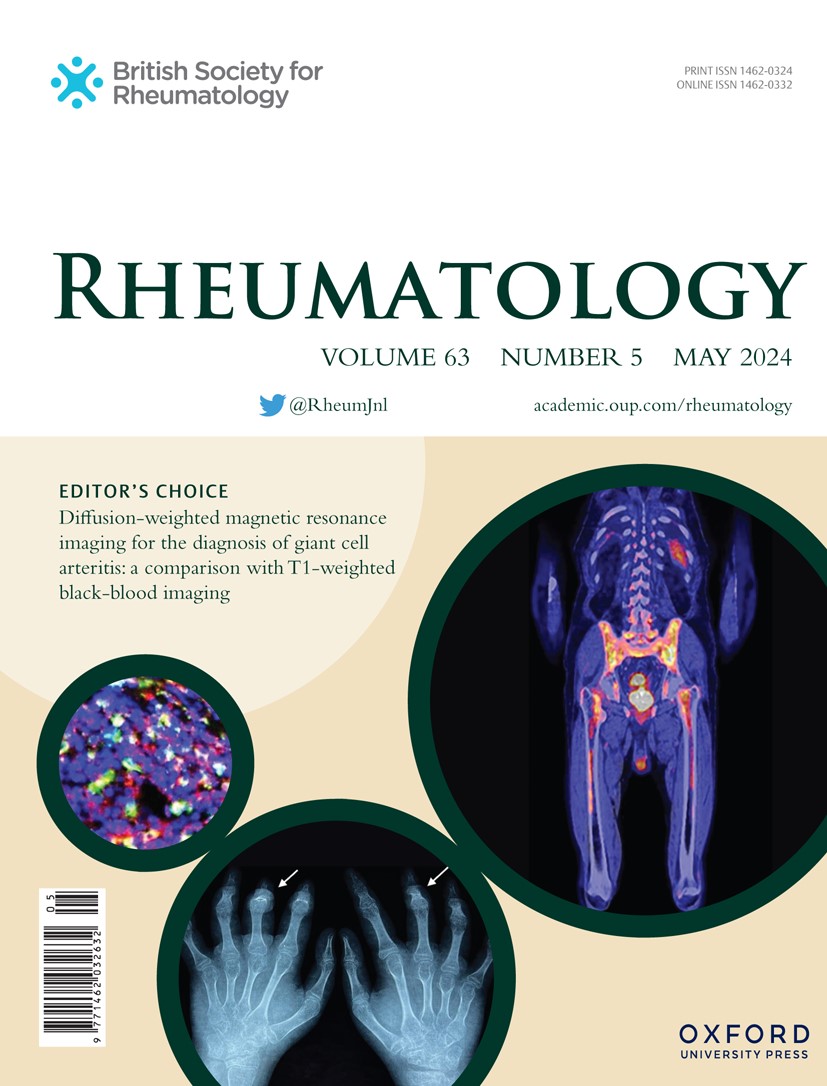系统性红斑狼疮患者临床惰性相关的因素和结果:一项多中心LUNA队列研究
IF 4.4
2区 医学
Q1 RHEUMATOLOGY
引用次数: 0
摘要
目的:本研究旨在确定系统性红斑狼疮(SLE)治疗中临床惰性的预测因素,并评估其对临床结果的影响。方法采用日本多中心LUNA队列的数据进行历史队列研究。365例基线前1年的活动性疾病患者(SLE疾病活动性指数评分bbbb4或活动性胃肠道病变或溶血性贫血)根据基线疾病活动性和1年内治疗强化状态分为非强化组(n = 247)和强化组(n = 118)。此外,将临床惯性组(n = 116)与非临床惯性组(n = 249)(包括所有其他患者)进行比较,临床惯性组定义为持续活动性疾病,无加剧。回归分析评估了预测因素和结果,包括损害累积、疾病活动性、生活质量(QoL)和患者满意度。结果非强化与糖皮质激素相关损伤的较大增加有关,而临床惰性与总体和糖皮质激素相关损伤的较大增加有关。非强化和临床惰性与几个领域中生活质量降低的趋势相关。羟氯喹的使用和伴随免疫抑制剂的减少预示着治疗的非强化,而女性和更大的损伤累积预示着临床惰性;年龄越大,这两种结果的趋势相似,但不显著。结论临床惰性可导致损伤加重和生活质量恶化,避免临床惰性是治疗的重点。定期重新评估治疗策略对老年患者、妇女和损伤较大的患者至关重要。根据个人风险状况主动调整治疗可以阻止临床惰性并改善长期结果。本文章由计算机程序翻译,如有差异,请以英文原文为准。
Factors and outcomes related to clinical inertia in systemic lupus erythematosus: a multicentre LUNA cohort study.
OBJECTIVES
This study aimed to identify predictors of clinical inertia in systemic lupus erythematosus (SLE) management and to evaluate its impact on clinical outcomes.
METHODS
A historical cohort study was conducted using data from the multicentre LUNA cohort in Japan. The 365 patients with active disease 1 year before baseline (SLE Disease Activity Index score >4 or active gastrointestinal lesions or haemolytic anaemia) were classified by baseline disease activity and treatment intensification status over 1 year into non-intensification (n = 247) vs intensification (n = 118) groups. Furthermore, the clinical inertia group (n = 116), defined as sustained active disease without intensification, was compared with the non-clinical inertia group (n = 249), which comprised all other patients. Regression analyses assessed predictors and outcomes, including damage accrual, disease activity, quality of life (QoL), and patient satisfaction.
RESULTS
Non-intensification was associated with larger increases in glucocorticoid-related damage, while clinical inertia was linked to greater increases in overall and glucocorticoid-related damage. Non-intensification and clinical inertia correlated with a tendency towards reduced QoL across several domains. Hydroxychloroquine use and fewer concomitant immunosuppressants predicted non-intensification of treatment, whereas female sex and greater damage accrual predicted clinical inertia; older age showed similar but non-significant trends for both outcomes.
CONCLUSION
Because clinical inertia can drive damage accrual and QoL deterioration, avoiding clinical inertia is a therapeutic priority. Regular reassessment of treatment strategy is essential for older patients, women, and those with greater damage. Proactive tailoring of treatment to individual risk profiles can arrest clinical inertia and improve long-term outcomes.
求助全文
通过发布文献求助,成功后即可免费获取论文全文。
去求助
来源期刊

Rheumatology
医学-风湿病学
CiteScore
9.40
自引率
7.30%
发文量
1091
审稿时长
2 months
期刊介绍:
Rheumatology strives to support research and discovery by publishing the highest quality original scientific papers with a focus on basic, clinical and translational research. The journal’s subject areas cover a wide range of paediatric and adult rheumatological conditions from an international perspective. It is an official journal of the British Society for Rheumatology, published by Oxford University Press.
Rheumatology publishes original articles, reviews, editorials, guidelines, concise reports, meta-analyses, original case reports, clinical vignettes, letters and matters arising from published material. The journal takes pride in serving the global rheumatology community, with a focus on high societal impact in the form of podcasts, videos and extended social media presence, and utilizing metrics such as Altmetric. Keep up to date by following the journal on Twitter @RheumJnl.
 求助内容:
求助内容: 应助结果提醒方式:
应助结果提醒方式:


